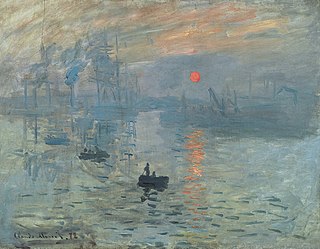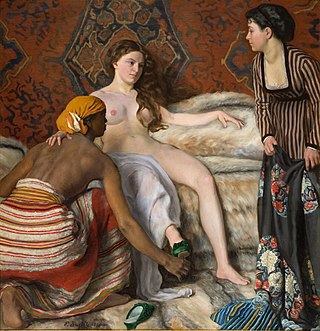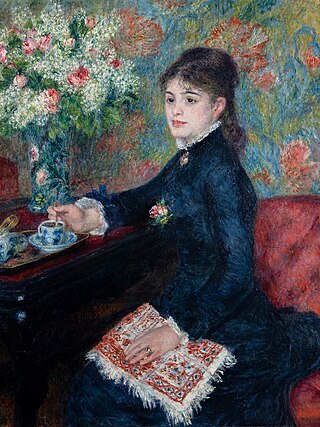
Jean Frédéric Bazille was a French Impressionist painter. Many of Bazille's major works are examples of figure painting in which he placed the subject figure within a landscape painted en plein air.

Impressionism was a 19th-century art movement characterized by relatively small, thin, yet visible brush strokes, open composition, emphasis on accurate depiction of light in its changing qualities, ordinary subject matter, unusual visual angles, and inclusion of movement as a crucial element of human perception and experience. Impressionism originated with a group of Paris-based artists whose independent exhibitions brought them to prominence during the 1870s and 1880s.

Pierre-Auguste Renoir was a French artist who was a leading painter in the development of the Impressionist style. As a celebrator of beauty and especially feminine sensuality, it has been said that "Renoir is the final representative of a tradition which runs directly from Rubens to Watteau."

In Summer is an 1868 oil-on-canvas painting by Pierre-Auguste Renoir, a portrait of Lise Tréhot aged about 20.

Parisian Women in Algerian Costume (The Harem), sometimes known as Interior of a Harem in Montmartre (Parisian Women Dressed in Algerian costumes), is a painting by Pierre-Auguste Renoir, completed 1872, which Renoir created in homage to Eugène Delacroix's Women of Algiers in their Apartment (1834, Louvre). It was rejected for entry to the 1872 Paris Salon, disliked by the artist and eventually sold for a small sum as part of a larger lot. It is now in the National Museum of Western Art, Tokyo.

Skaters in the Bois de Boulogne is an oil-on-canvas landscape painting by the French artist Pierre-Auguste Renoir, created during the winter of 1868. The painting depicts a snowscape with many Parisians, young and old, spending leisure time on a frozen park lake. Due to Renoir's strong dislike of cold temperatures and snow, the piece is one of his few winter landscapes.

La Promenade is an oil on canvas, early Impressionist painting by the French artist Pierre-Auguste Renoir, created in 1870. The work depicts a young couple on an excursion outside of the city, walking on a path through a woodland. Influenced by the Rococo Revival style during the Second Empire, Renoir's La Promenade reflects the older style and themes of eighteenth-century artists like Jean-Honoré Fragonard and Jean-Antoine Watteau. The work also shows the influence of Claude Monet on Renoir's new approach to painting.

Lise with a Parasol is an oil on canvas painting by French artist Pierre-Auguste Renoir, created in 1867 during his early Salon period. The full-length painting depicts model Lise Tréhot posing in a forest. She wears a white muslin dress and holds a black lace parasol to shade her from the sunlight, which filters down through the leaves, contrasting her face in the shadow and her body in the light, highlighting her dress rather than her face. After having several paintings rejected by the Salon, Renoir's Lise with a Parasol was finally accepted and exhibited in May 1868.

Woman with Parakeet is a painting by Pierre-Auguste Renoir created in 1871. It is in the holdings of the Solomon R. Guggenheim Museum in New York as part of the Thannhauser Collection. The painting portrays model Lise Tréhot, who posed for Renoir in over twenty paintings during the years 1866 to 1872.

Marguerite Charpentier was a French salonist and art collector who was one of the earliest champions of the Impressionists, especially Pierre-Auguste Renoir.

La Toilette is an oil-on-canvas painting by the 19th century French impressionist artist Frédéric Bazille, executed in 1869–1870, which has been in the collection of the Musée Fabre in Montpellier, France since 1968. He produced it a few months before his death in the Franco-Prussian War in 1870.

Bazille's Studio is an oil-on-canvas painting created in 1870 by the French Impressionist Frédéric Bazille. The painting is also known as L'Atelier de la rue Condamine, The Studio, and The Studio on the Rue La Condamine. It has been in the collection of the Musée d'Orsay in Paris since 1986. It shows the artist himself surrounded by his friends and paintings in his studio, capturing the artistic and social conditions of Paris in 1870.

Diana is a painting from 1867 by the French painter Pierre-Auguste Renoir. It is thought to depict the painter's lover Lise Tréhot as the Roman goddess Diana, although the exact identification of the model in the painting is disputed by art historians.

The Batignolles group was a group of young avant-garde painters from the end of the 19th century who gathered around Édouard Manet. The group bears its name in reference to the Batignolles district, where the artists used to meet between 1869 and 1875. Many of the artists in the group later became known for the Impressionism movement.

Bather with a Griffon Dog is an 1870 oil-on-canvas painting by French artist Pierre-Auguste Renoir. The painting features his lover and model Lise Tréhot (1848-1922). The work was exhibited at the 1870 Salon. The painting is held in the collection of the São Paulo Museum of Art.

Madame Georges Charpentier and Her Children is an 1878 oil on canvas painting by Pierre-Auguste Renoir. It depicts Marguerite Charpentier, a French salonist, art collector, and advocate of the Impressionists, and her children Georgette and Paul. The painting is held by the Metropolitan Museum of Art.

A Couple also known as The Engaged Couple or Alfred Sisley and his Wife, is an oil-on-canvas painting by the French artist Pierre-Auguste Renoir (1841–1919), created around 1868 during his early Salon period at a time when he focused on thematic works about couples. It was acquired by the Wallraf–Richartz Museum in 1912.

Femme en costume Mauresque is an oil-on-canvas painting by the 19th-century French impressionist artist Frédéric Bazille, completed in 1869. It has been in the collection of the Norton Simon Museum in Pasadena, California, since 1997.
Jules Le Cœur was a French architect and painter and a friend and early supporter of Pierre-Auguste Renoir (1841–1919). Le Cœur also appeared as a subject in two of Renoir's paintings, Mother Anthony's Tavern and Jules Le Cœur and his dogs in the forest of Fontainebleau, both in 1866. Jules was the son of Joseph Le Cœur, a carpenter, and Catherine Félicie Jaullain. The architect Charles Le Cœur was his brother. Like his brother, Jules was also an architect and a student of Henri Labrouste. He married Marianne Bouwens in 1861, but she died shortly thereafter in 1863. Subsequently, Le Cœur gave up architecture and devoted himself to painting. By 1865, he was spending time at a house in Bourron-Marlotte and painting in the Fontainebleau forest with Renoir. At the same time, Le Cœur began a relationship with Clémence Tréhot while Renoir was involved with her sister Lise Tréhot who also became his model. Le Cœur died at his home on the rue Campagne-Première at the age of 49 in 1882.

The Cup of Chocolate is an oil on canvas painting by the French artist Pierre-Auguste Renoir (1841–1919), featuring a model known as Margot. The painting, dated between 1877 and 1878, depicts a portrait of a young French bourgeois woman drinking either coffee or chocolate in a setting of luxury. Formerly held by private collectors, the painting was acquired by the Louvre Abu Dhabi in 2022.














































